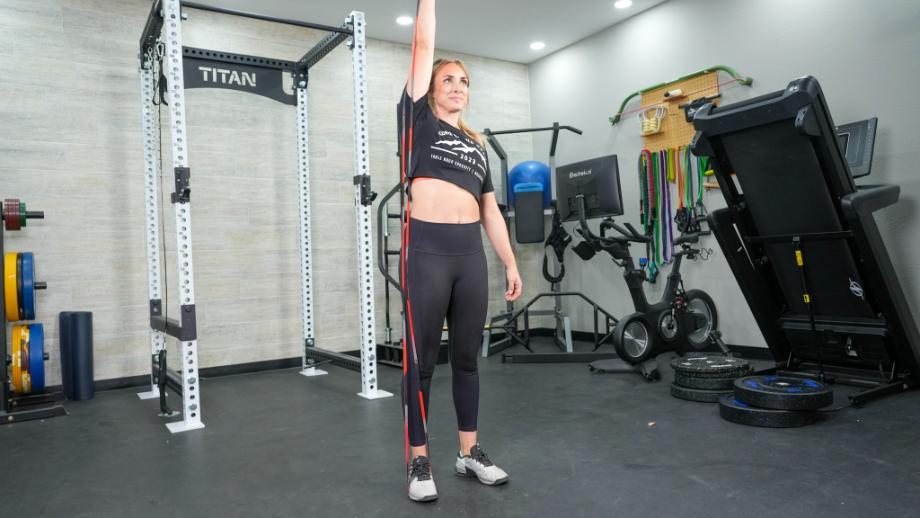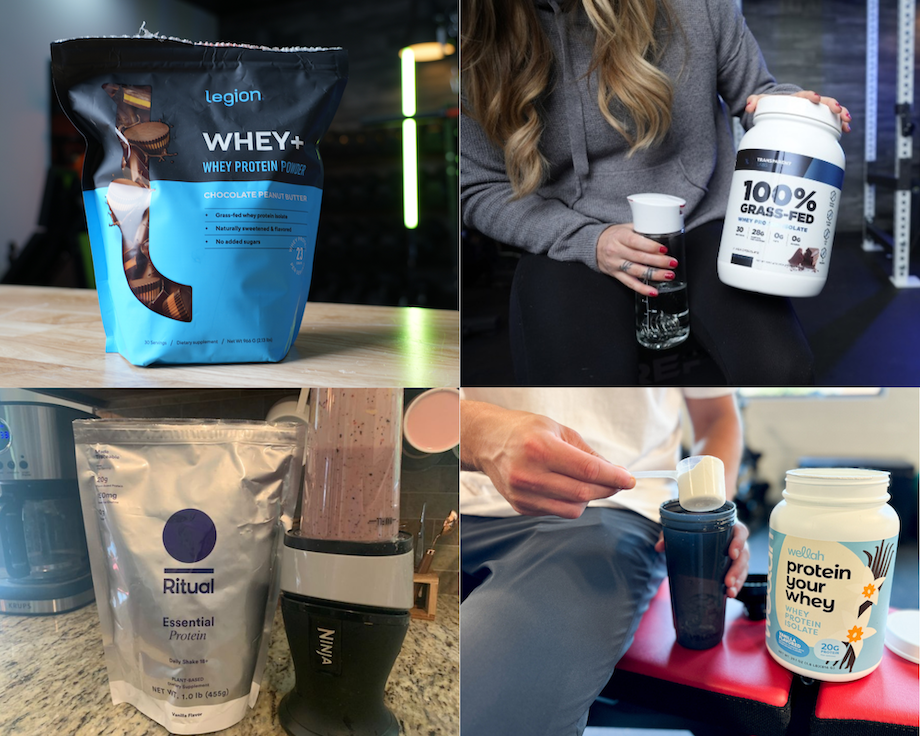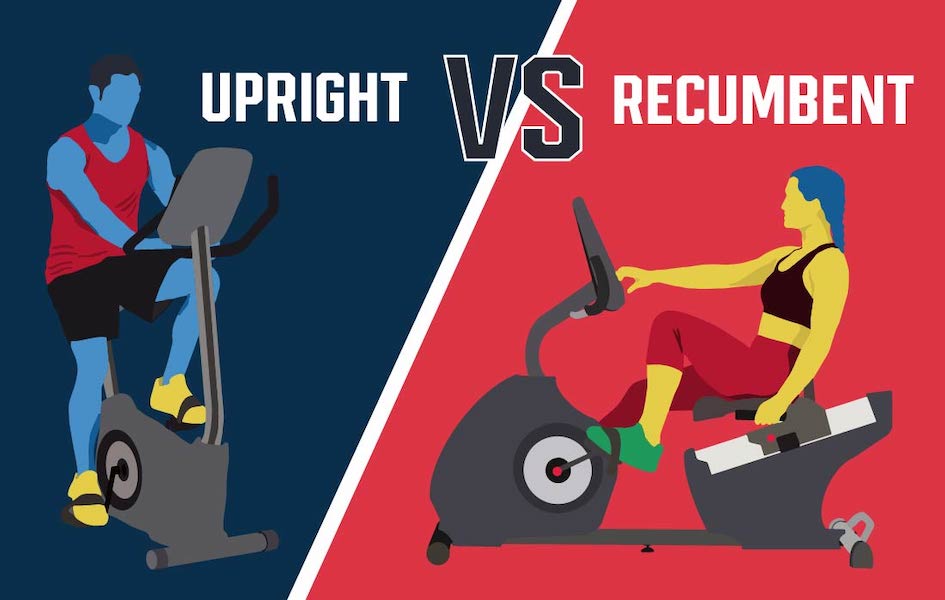There are plenty of workout programs that revolve around free weight exercises and cardio machines, but did you know you can get a full-body workout with just resistance bands?
That’s right; that lightweight length of rubber can provide muscle activation virtually everywhere, as long as you know the right moves. We asked Caine Wilkes, OLY, USAW-L1, and GGR senior staff writer, to share the best resistance band exercises, including why and how to do each move, sample workouts, and more!
So, grab yourself a set of the best resistance bands, complete your warm-up, and let’s get to work!
16 Best Resistance Band Exercises
- Band Glute Bridge
- Band Push-Up
- Band Bike Crunch
- Band Wood Chop
- Band Lateral Walk
- Band Pull-Apart
- Band Chest Press
- Band Biceps Curl
- Band Triceps Extension
- Band Overhead Press
- Band Lateral Raise
- Band Squat
- Band Good Morning
- Band Kickback
- Band Seated Row
- Band Pull-Up
Band Glute Bridge
Muscles worked: Glutes, hamstrings, core, lower back, and hip adductors
Benefits: “Bodyweight glute bridges are already good for blasting your core and building lower-body muscles, but adding a resistance band around your knees helps improve hip mobility and strength, too,” says Caine Wilkes, OLY, USAW-L1.
How to do it:
- Lie supine (on your back) on the ground (or on one of the best exercise mats) with your knees bent, feet flat on the floor, arms extended at your sides, palms pressed into the floor, and a resistance band wrapped around your thighs, just above your knees.
- Thrust your hips upward, keeping your shoulders and upper back pressed into the floor. Push your knees outward as you move to fight against the resistance band.
- Continue until your body forms a straight line from your knees to your shoulders.
- Squeeze your glutes at the top, then slowly lower your torso back to the floor.
- Repeat for reps.
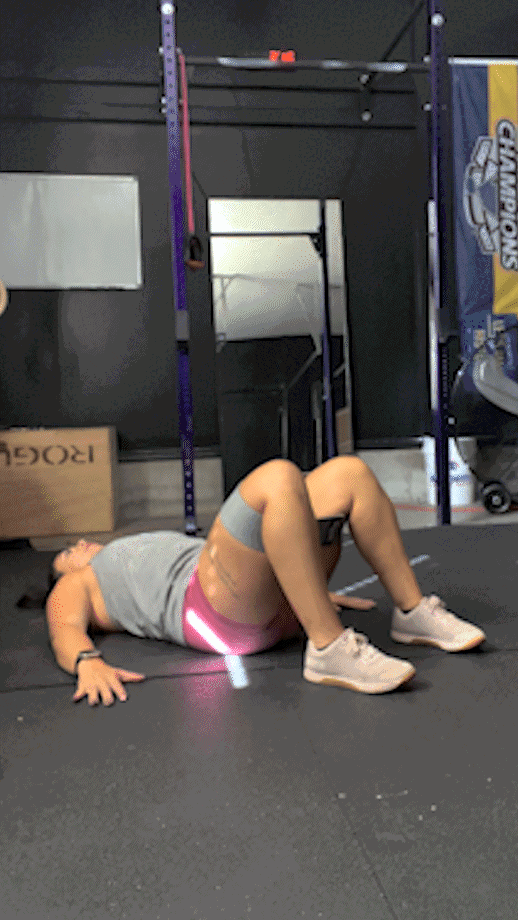
Modifications
- Dial it back: Perform regular bodyweight glute bridges.
- Make it harder: Use a heavier resistance band, place a free weight in your lap, perform the single-leg version, or substitute the glute bridge for the hip thrust exercise.
Band Push-Up
Muscles worked: Pectoralis major, triceps, anterior delts, core
Benefits: Regular push-ups allow some reprieve in the starting position, but not when using resistance bands. The constant tension provided by the band means you’ll have to fight against resistance in the starting position and manage your body weight at the bottom of your push-up, so it’s double the trouble!
How to do it:
- Get on all fours and wrap a resistance band around your upper back and shoulders.
- Hold the other end of the resistance band loop in your hands and push the band into the floor as you get into your push-up position.
- Slowly bend your elbows, keeping them tucked into your torso, to lower yourself down.
- Continue until your chest lightly touches the floor.
- Push yourself back up by extending your elbows.
- Repeat for reps.
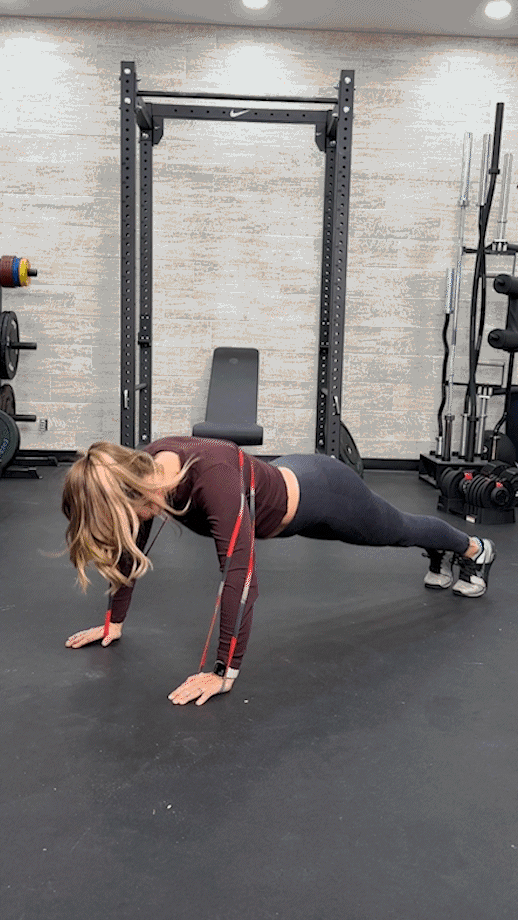
Modifications
- Dial it back: Ditch the resistance band and do regular push-ups.
- Make it harder: Swap out standard band push-ups for one of these push-up variations.
Band Bike Crunch
Muscles worked: Rectus and transversus abdominis, obliques, hip flexors and adductors
Benefits: According to the American Council on Exercise1, the bicycle crunch is the best exercise for strengthening the rectus abdominis and ranks second best in terms of oblique activation. Throwing a mini-band around your feet makes that killer movement even deadlier by providing further activation to your core, quads, and hip flexors.
How to do it:
- Lie on your back and place a mini-band around your feet.
- Lift your legs off the floor and clasp your fingers behind your head.
- Drive your left knee toward your chest, bringing the right elbow across the body to meet it. Keep your right leg extended.
- Extend the left leg as you drive your right knee toward your chest, meeting it with your left elbow across the body.
- Continue alternating sides until you complete the desired number of repetitions.
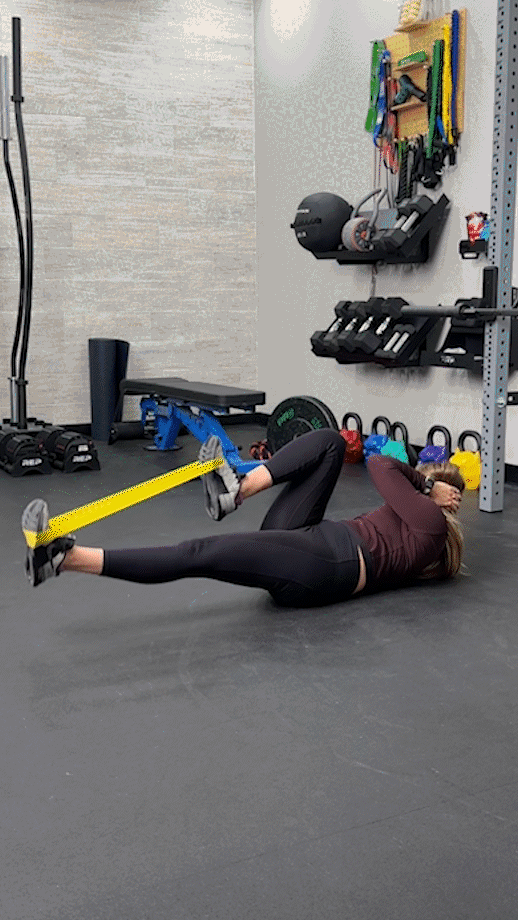
Modifications
- Dial it back: Lose the mini-band and do regular bicycle crunches instead.
- Make it harder: Progress to this cable ab workout to add even more resistance.
Band Wood Chop
Muscles worked: Shoulders, glutes, core
Benefits: “The wood chop exercise is excellent,” says Caine. “It’s a functional movement, so it helps build better biomechanics that translates to other exercises and movement patterns, that hits muscle groups throughout the entire body, builds anti-rotational strength, core strength and stability, and, the best part, you can do it with a resistance band!”
How to do it:
- Stand with your feet shoulder-width apart with a looped resistance band beneath your right foot.
- Grip the other end of the band with a mixed grip—left hand underhand, right hand overhand.
- Raise both arms over your left shoulder, keeping your elbows extended, core tight, and glutes engaged.
- Swing your arms across your body toward your right hip.
- Repeat for reps, then position the resistance band beneath your left foot and do your next set swinging from your right shoulder to left hip.
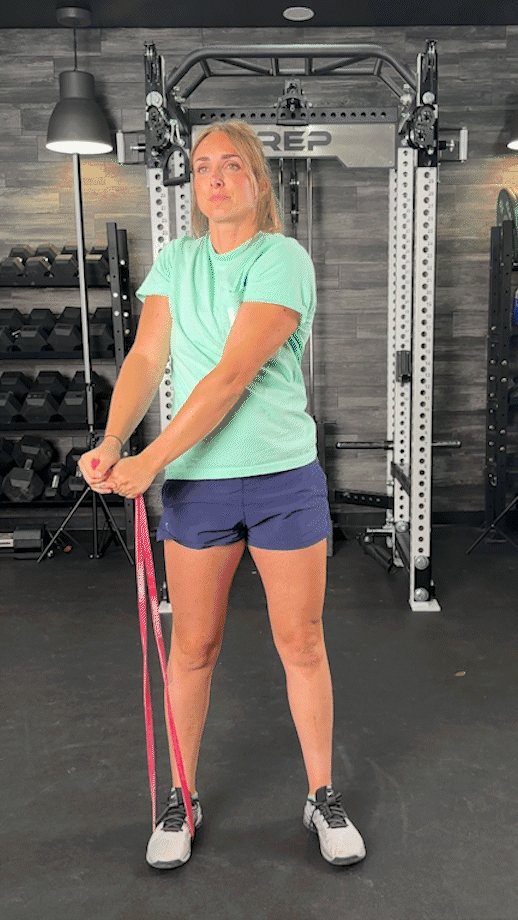
Modifications
- Dial it back: Perform the wood chop exercise with a light medicine ball, dumbbell, or no resistance whatsoever to learn and master the movement pattern.
- Make it harder: Trade your band for a cable machine so you can get even more resistance.
Band Lateral Walk
Muscles worked: Glutes, hip adductors, core
Benefits: Wrapping a mini-band around your legs and stepping sideways seems unassuming, but this simple movement provides major activation to your glutes and hips. The result is an increase in strength and mobility in your hips, plus an overall greater range of motion.
How to do it:
- Wrap a mini-band around your thighs and bend your knees slightly.
- Take one small step to the side, fighting against the resistance of the band.
- Continue for distance or until you complete the desired number of repetitions.
- Repeat the set on your other side.

Modifications
- Dial it back: Perform a regular lateral walk or bodyweight lateral lunges.
- Make it harder: Use a thicker resistance band (more resistance) or position the band around your ankles to stretch the band farther to step.
Band Pull-Apart
Muscles worked: Traps, rhomboids, posterior delts, biceps, triceps, forearms
Benefits: The band pull-apart is another simple move that stretches and strengthens the chest, arms, and shoulders while practicing scapular movement, including retraction and protraction. You can use it to build muscle and strength or as a warm-up exercise before a heavy chest day.
How to do it:
- Hold a resistance band in front of your chest with your arms nearly fully extended.
- Pull the band apart until it’s lightly touching your upper body.
- Squeeze your shoulder blades together at the end of the movement.
- Slowly return your arms to the starting position.
- Repeat for reps.
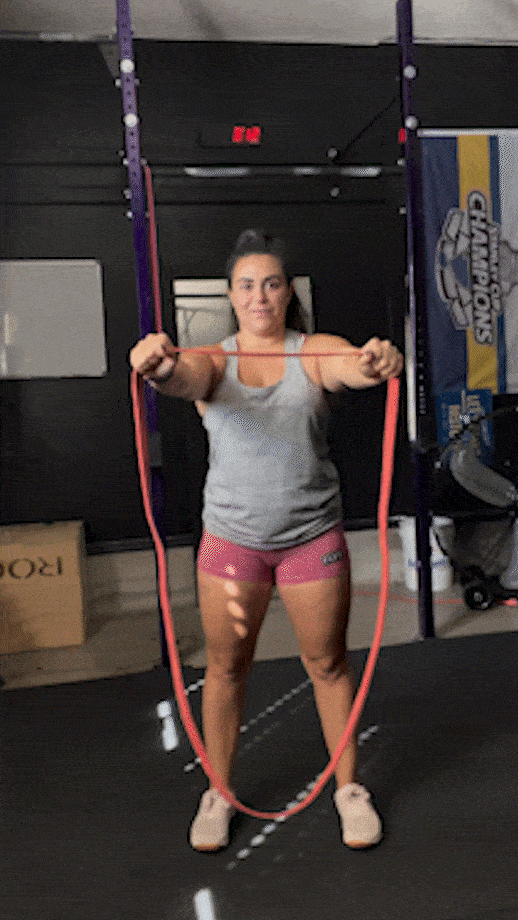
Modifications
- Dial it back: Choose an easier resistance band or simply stretch your arms out to your sides, pinch your shoulder blades together, and practice stretching without the band.
- Make it harder: You can use a thicker resistance band, but progressing to advanced movements like the face pull, dumbbell fly, or reverse pec deck can be very effective.
Band Chest Press
Muscles worked: Pectorals, anterior delts, triceps
Benefits: “There are some unique benefits associated with the band chest press,” says Caine. “Like the regular bench or chest press, you’ll receive muscle activation in the chest and triceps. The elastic tension also increases your stability and core engagement while improving your movement efficiency.”
How to do it:
- Anchor your resistance band slightly below chest height.
- Stand with your feet shoulder-width apart, your back to the anchor point, your elbows bent, and the resistance band held with both hands.
- Step forward until you feel tension in the band.
- Press the band forward until your elbows are nearly fully extended.
- Squeeze your pecs, then slowly return your arms to the starting position.
- Repeat for reps.
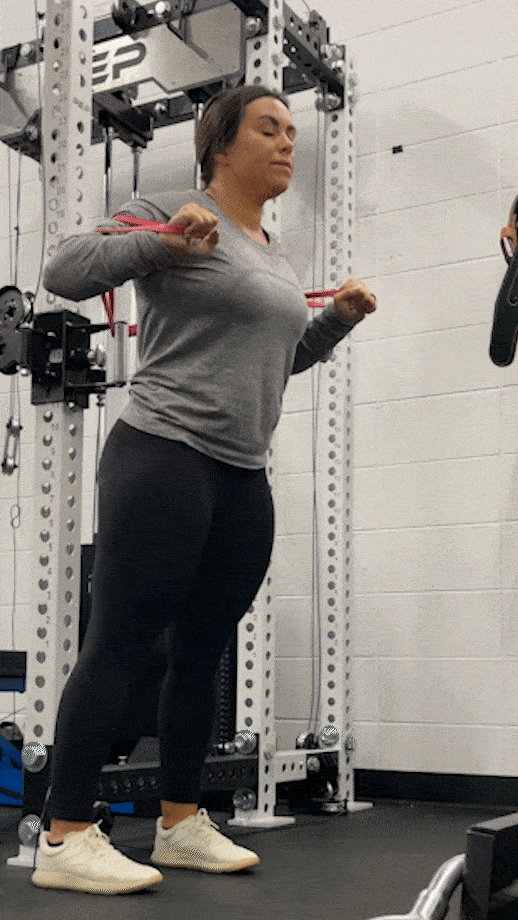
Modifications
- Dial it back: Starting out on a chest press machine will help you learn the movement pattern more easily since the machine keeps you on a fixed path.
- Make it harder: The traditional bench press is the natural next step. If you’re really proficient, you may consider doing the barbell bench press with a resistance band wrapped around the bar, but this is considered very advanced and should not be attempted without a certified personal trainer or strength coach by your side.
Band Biceps Curl
Muscles worked: Biceps, forearms, anterior delts
Benefits: Biceps curls and resistance bands are a match made in heaven. Because the variable resistance is most intense at the top of your curl when the bicep is fully contracted, you’ll get a fantastic pump!
How to do it:
- Stand with your feet shoulder-width apart with the elastic band held down by both feet.
- Hold the other side of the band with your arms extended and your palms facing up.
- Bend your elbows to curl the band toward your shoulders.
- Squeeze your biceps at the top, then slowly lower the band back down.
- Repeat as needed.
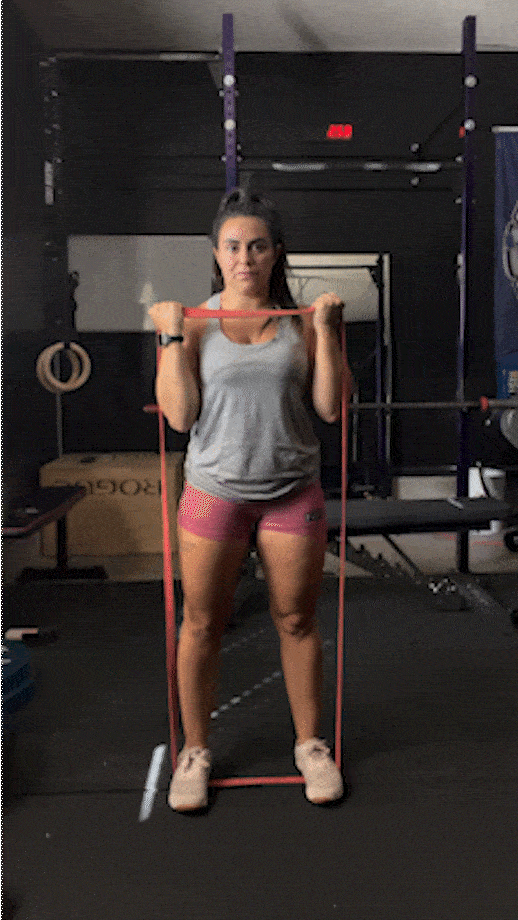
Modifications
- Dial it back: Use the lightest possible resistance band.
- Make it harder: Use your resistance band to do the 21s workout.
Band Triceps Extension
Muscles worked: Triceps, shoulders, chest, lats, forearms
Benefits: Few exercises target the triceps with as much intensity as the triceps extension, so it’s crucial to incorporate the band triceps exercise in any resistance band workout involving the arms or full-body activation.
How to do it:
- Position your resistance band beneath your right foot, holding the handles with both hands behind your head and your elbows fully bent.
- Step forward with your left foot to enter a staggered stance.
- Extend your elbows, keeping your upper arms stationary.
- Continue until you reach the overhead lockout position.
- Squeeze your triceps, then slowly bend your elbows to return to the starting position.
- Repeat for reps.
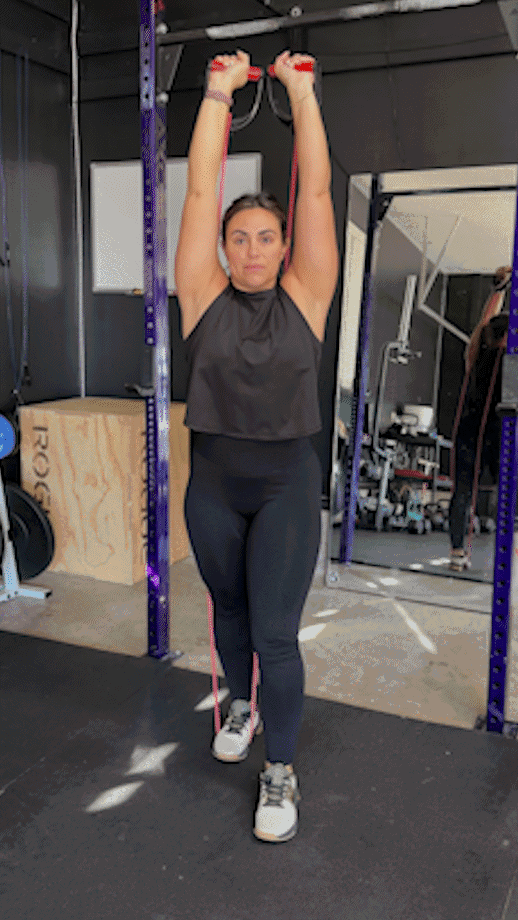
Modifications
- Dial it back: The triceps kickback also isolates the triceps, but many people find the movement easier than overhead extensions.
- Make it harder: Use a thicker resistance band, switch over to cable triceps extensions, or grab a bench and barbell for some skull crushers!
RELATED: 11 Triceps Extensions Variations
Band Overhead Press
Muscles worked: Traps, delts, triceps, chest, core
Benefits: “Overhead presses are a staple in my strength training routine,” says Caine. “They’re crucial for developing all-purpose upper-body strength, muscle, and power, but they also help teach good movement mechanics that translates to weightlifting and everyday life.”
How to do it:
- Stand with your feet shoulder-width apart, back flat, chest up, and core tight. Your resistance band should be positioned beneath both feet.
- Hold the other end of your elastic band with your hands at shoulder height, your palms facing the ceiling, and your elbows stacked beneath your wrists.
- Press the band toward the ceiling until your elbows are nearly fully locked out.
- Squeeze your shoulders and upper back at the top.
- Slowly lower the band back down with control.
- Repeat for reps.
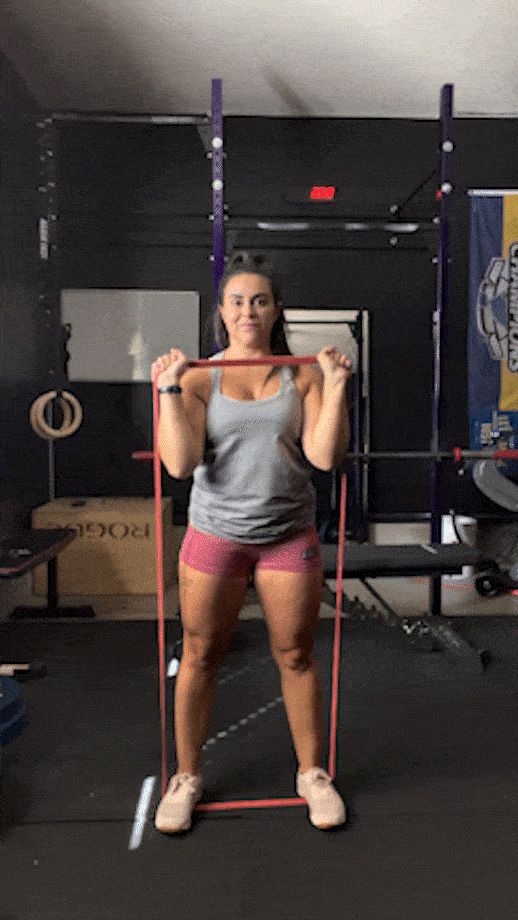
Modifications
- Dial it back: Swap out your resistance band for a pair of super light dumbbells or even a length of PVC pipe so you can practice the movement pattern with minimal resistance.
- Make it harder: Grab a thicker resistance band, switch over to the cable machine, or, if you’re really ready to ramp up the resistance, get your hands on an Olympic barbell.
Band Lateral Raise
Muscles worked: Delts, traps, serratus anterior
Benefits: Using a resistance band for your lateral raises provides the same isolation activation in the deltoids (with some minor activation to a few surrounding muscle groups). However, it generally feels easier due to the difference in the resistance type. So, you can really rack up the reps!
How to do it:
- Stand with your resistance band pinned to the floor by your feet.
- Hold the handles with your palms facing you and your arms at your sides.
- Pull the resistance band upward and outward, keeping your elbows extended.
- Continue until you reach approximately shoulder height.
- Squeeze your delts, then slowly return to the starting position.
- Repeat for reps.
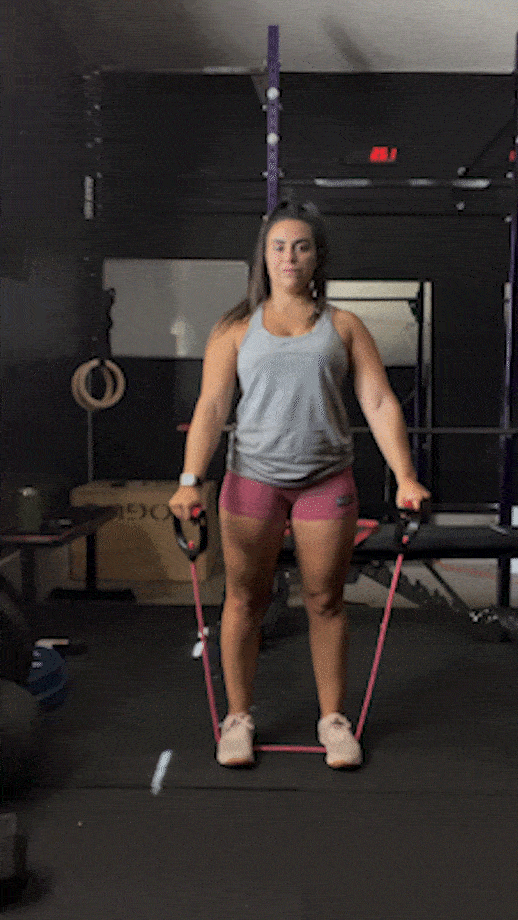
Modifications
- Dial it back: Bending your elbow a little shortens the lever and makes the move easier on your shoulders.
- Make it harder: Imposing a tempo makes band lateral raises more challenging. Alternatively, you can grab a pair of the best dumbbells to increase the weight.
RELATED: Tempo Training
Band Squat
Muscles worked: Quads, glutes, hamstrings, hip adductors, core
Benefits: Band squats serve as a perfect middle step for beginners who are ready to move on from bodyweight squats but not quite ready to tackle the barbell back squat. According to the Journal of Strength and Conditioning Research2, band squats “may…improve sprinting, [change of direction] ability, and jump explosiveness” when used during your warm-up.
How to do it:
- Stand with your feet shoulder-width apart and a resistance band positioned beneath them. Loop the other end over your head and across your shoulders and upper back or hold each end at shoulder height if using a band with handles.
- Push your hips back, bend your knees, and lower yourself into a squat position.
- Continue until your thighs are nearly parallel with the floor.
- Pause, then drive through your heels to stand.
- Squeeze your glutes at the top and bring your hips to full extension.
- Repeat for reps.
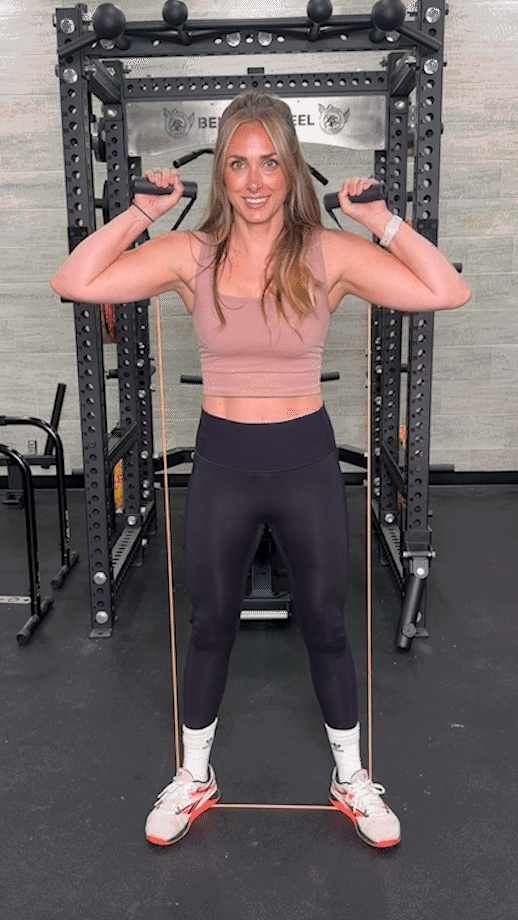
Modifications
- Dial it back: Set the resistance band aside and do bodyweight (air) squats instead.
- Make it harder: Move on up to the tried-and-true barbell back squat.
RELATED: How To Squat With Resistance Bands
Band Good Morning
Muscles worked: Glutes, hamstrings, lower back, core, calves, and upper back
Benefits: “The good morning exercise is incredible for stretching and strengthening the glutes and hamstrings, but it’s also excellent for practicing your hip hinge,” says Caine. “Like the band squat, adding an elastic band is perfect if you’re ready to move on from the bodyweight good morning but not quite ready to work with a barbell.”
How to do it:
- Stand with your feet shoulder-width apart and a resistance band positioned beneath them. Loop the other end over your head and across your shoulders and upper back.
- Push your hips back and lower your chest toward the floor, keeping your back straight and your legs mostly extended except for a slight bend in your knees.
- Continue until you feel a strong stretch in your hamstrings.
- Pause, then reverse the movement and bring your hips forward.
- Squeeze your glutes at the top and bring your hips to full extension.
- Repeat for reps.
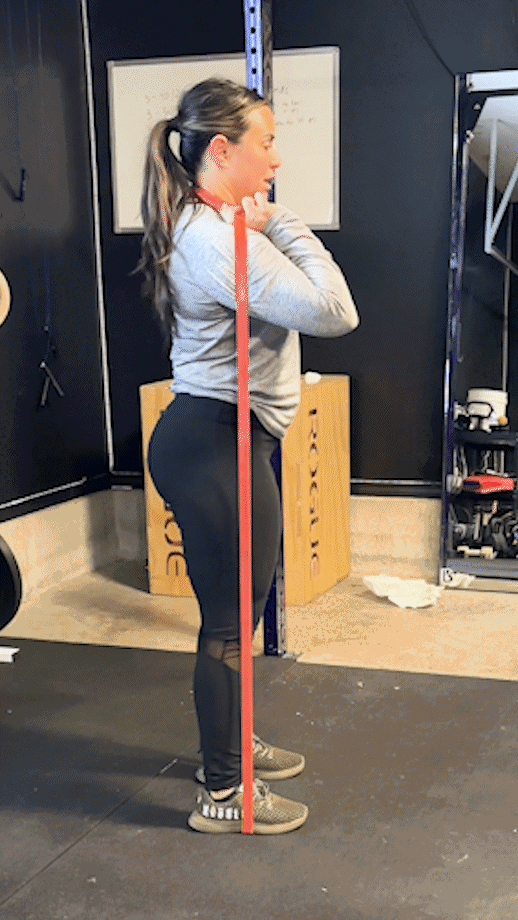
Modifications
- Dial it back: The bodyweight good morning is best for beginners locking in their hip hinge form. You can also practice this movement with a length of PVC pipe or a broom handle.
- Make it harder: Trading your resistance band for a barbell brings your good morning exercise to the next level. You may also consider progressing to the RDL as well.
Band Kickback
Muscles worked: Glutes, hamstrings, calves, and core
Benefits: Band kickbacks are for more than building your backside; they also train your hamstrings without having to flex your knee. That’s a major plus for people who have to work around knee issues, including pain, weakness, or preexisting injuries.
How to do it:
- Secure a mini-band around your ankles and stand with your feet shoulder-width apart. You can also loop your band around a squat rack if one is available.
- Place your hands on the wall (or rack support) in front of you for stability.
- “Kick” your right foot back without bending your knee.
- Continue until you feel a strong contraction in your glutes and hamstrings.
- Squeeze, then slowly return to the starting position.
- Repeat the movement with your left foot.
- Continue alternating sides until you finish the set.
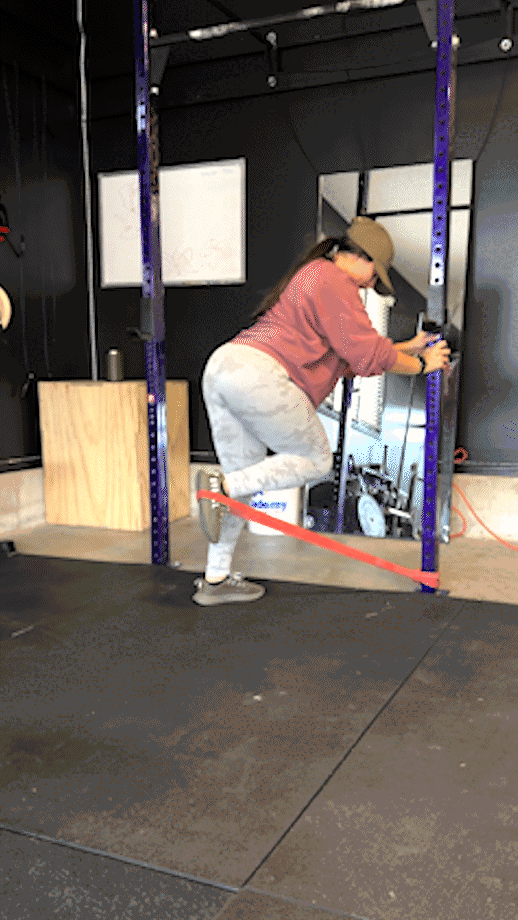
Modifications
- Dial it back: Losing the resistance band and performing a donkey kick or fire hydrant lets you practice the movement and still enjoy some contraction to the target muscles, making it more beginner-friendly.
- Make it harder: Progressing to thicker resistance bands will make the movement more challenging. Getting in a few sets on the glute kickback machine at the gym will enable you to increase the resistance as well while still using basically the same movement.
RELATED: Glute Exercises At Home
Band Seated Row
Muscles worked: Latissimus dorsi, rhomboids, traps, erector spinae, biceps, triceps, core
Benefits: The seated row is one of the more common back exercises, so you’re probably in luck if you endeavor to do this back-building staple at any commercial gym in the country. Not everyone has room for a cable machine in their home gym, but thanks to resistance bands, you don’t need one to do your seated rows at home!
How to do it:
- Sit on the floor with your legs fully extended in front of you.
- Wrap a resistance band around your feet and lean forward to grip the handles.
- Pull the handles towards your body, leading with your elbows.
- Continue until your elbows pass your torso and your shoulder blades pinch together.
- Squeeze the contraction, then slowly guide the handles back to the start.
- Repeat for reps.
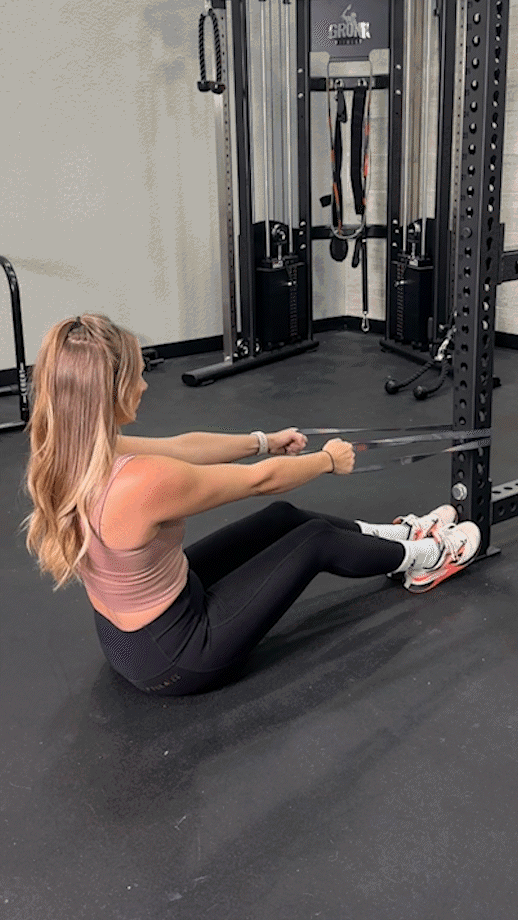
Modifications
- Dial it back: Reduce the range of motion or consider performing single-arm dumbbell rows using a light dumbbell in order to build the target muscles and a solid foundation.
- Make it harder: Hop on the seated row machine and start working towards progressive overload. Making good use of different row variations may help you progress, too.
Band Pull-Up
Muscles worked: Lats, biceps, traps, delts, pecs, rhomboids, serratus anterior, core
Benefits: “Pull-ups are among the best bodyweight exercises at your disposal, but the problem is they’re exceedingly difficult,” says Caine. “That’s where the band pull-up comes in. It gives you some assistance to help you develop the required muscles and practice the movement.”
How to do it:
- Wrap a resistance band around a pull-up bar and make sure it’s secure.
- Grip the pull-up bar using an overhand grip and step one foot into the loop of the resistance band, dropping into a supported dead hang.
- Pull yourself up toward the bar. The band will assist your movement.
- Continue until your chin passes over the bar.
- Pause, then lower yourself back down with control.
- Repeat for reps.

Modifications
- Dial it back: Inverted rows, dead hangs, negative pull-ups, and jumping pull-ups are all great ways to modify the movement further and build the required muscles.
- Make it harder: Using progressively lighter resistance bands until you’re able to do an actual pull-up is an impressive feat in and of itself, but you can push your pull-up game even further by taking on chest-to-bar pull-ups, L-sit pull-ups, and even bar muscle-ups.
RELATED: Pull-Up Variations
Sample Resistance Band Workouts
Resistance band exercises provide muscle activation virtually everywhere. So, with the right exercise selection, you can get a full-body workout or target a specific region to build strength, muscle, and power.
Here are a few sample workouts to give you a little fitspiration!
Resistance Band Workout For Your Upper Body
Our upper-body resistance band workout is low-impact, joint-friendly, and hits all the major upper-body muscle groups for maximum activation and maximum results!
| Exercise | Sets | Reps |
| Band Pull-Apart | 2-3 | 15-20 |
| Band Chest Press | 2-3 | 12-15 |
| Band Biceps Curl | 2-3 | 12-15 |
| Band Overhead Press | 2-3 | 12-15 |
| Band Lateral Raise | 2-3 | 12-15 |
| Band Triceps Extension | 2-3 | 12-15 |
Resistance Band Workout For Your Lower Body
Likewise, if you’re looking for a way to build strength in the legs and posterior chain, our lower-body resistance band workout is sure to give you what you need.
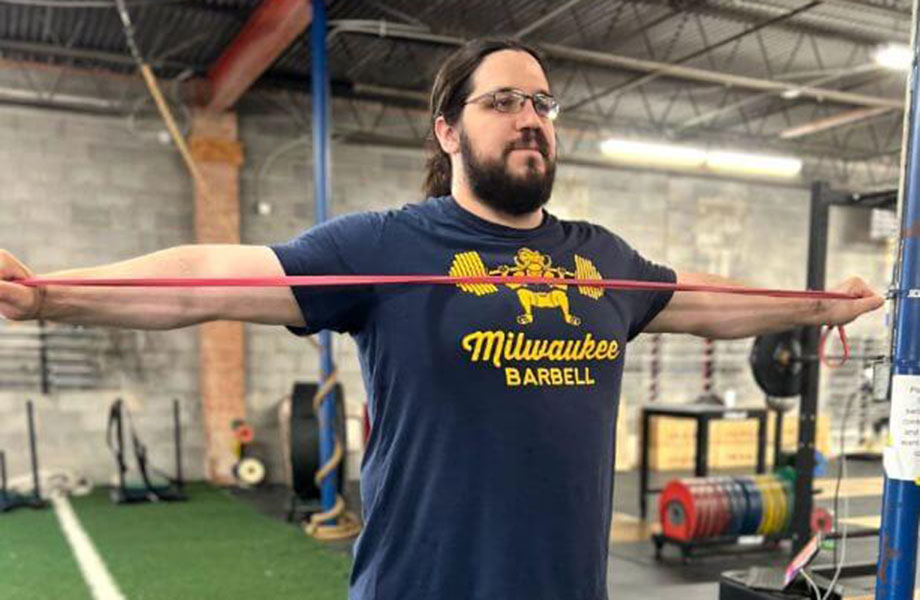
Try this one on for size on your next leg day!
| Exercise | Sets | Reps |
| Band Good Morning | 2-3 | 12-15 |
| Band Squat | 2-3 | 12-15 |
| Band Kickback | 2-3 | 12-15 |
| Band Glute Bridge | 2-3 | 12-15 |
| Band Lateral Walk | 2-3 | 12-15 |
Full-Body Resistance Band Workout
We love training splits, but sometimes a total-body blaster is just the thing to help you hit all your major muscle groups in record time. After all, time is a commodity in today’s frenzied society, so making good use of compound exercises will go a long way in ensuring your workouts pack the punch you need to get results!
| Exercise | Sets | Reps |
| Band Push-Up | 2-3 | 12-15 |
| Band Glute Bridge | 2-3 | 12-15 |
| Band Squat | 2-3 | 12-15 |
| Band Overhead Press | 2-3 | 12-15 |
| Band Biceps Curl | 2-3 | 12-15 |
| Band Triceps Extension | 2-3 | 12-15 |
| Band Lateral Walk | 2-3 | 12-15 |
| Band Pull-Up | 2-3 | 12-15 |
RELATED: Full-Body Workout Vs Split
Benefits of Resistance Band Training
Naysayers may mistakenly believe that there’s no way you can get a high-quality workout with a tiny length of rubber, a few key movements, and that’s it. Surely, you need specialized machines, barbells, dumbbells, and kettlebells to actually get results, right?
Wrong!
Resistance band exercises can be as effective as free weight exercises and, in some ways, even better. Here are some of the most important benefits of resistance band training.
RELATED: Free Weights Vs Resistance Bands
They’re More Convenient
Okay, before we get into the research-backed reasons why resistance bands make an excellent training tool, let’s begin by stating the obvious: resistance bands are way more convenient than free weights and machines.
Resistance bands are relatively inexpensive, lightweight, portable, versatile—the list goes on! As illustrated above, you can get a full-body workout with just resistance bands. All you need is a few resistance levels to work with, and you’ve got it made!
They’re Effective
Free-weight enthusiasts may balk at the notion, but studies show that resistance band training may absolutely be as effective as free-weight or machine-based training. In fact, a 2019 review published in SAGE Open Medicine3 concluded that “elastic resistance training is able to promote similar strength gains to conventional resistance training.”
That’s not all; a 2022 review published in Frontiers in Physiology4 determined resistance band training “improved body fat in overweight or obese people better than other resistance training types,” making resistance band exercise viable for weight loss, too.
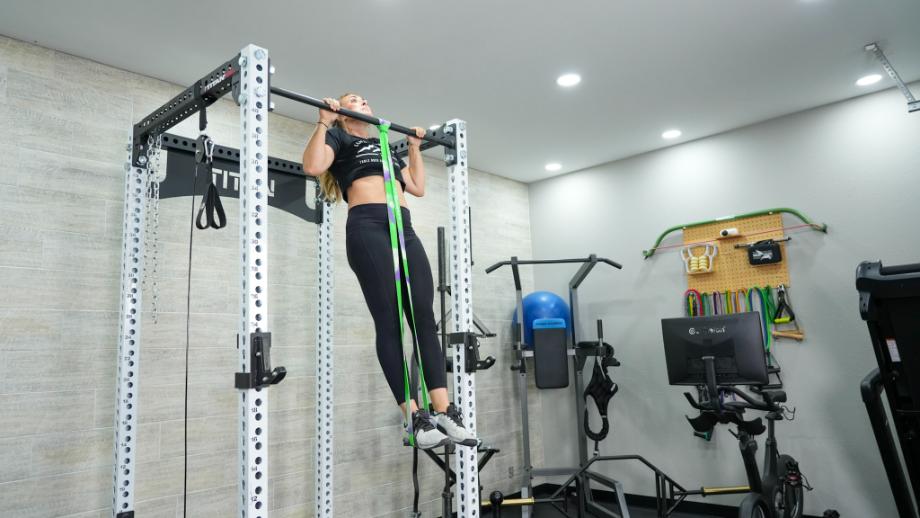
Whether you’re looking to build strength and muscle, lose weight, or promote overall well-being, resistance band training can be an effective tool for working towards and achieving those goals.
They’re Beginner-Friendly
One of the intangible reasons resistance bands are so effective is because, unlike intricate machines and intimidating free weights, resistance bands are super approachable.
According to the Journal of Aging and Physical Activity5, resistance band exercises “may benefit individuals who are unable to tolerate or participate in more strenuous exercise programs,” as researchers observed improvements to various health markers in their participants.
Resistance bands are less daunting than other training tools because they impose less resistance than other modalities. They’re also valuable for individuals unable to participate in high-intensity exercise, heavy weightlifting, or other intermediate to advanced exercise programs.
Resistance Band Exercises: Final Thoughts
There’s no need to resist; resistance band exercises rank as some of the best you can do in the gym. Resistance bands:
- Can provide a full-body workout
- Are convenient, lightweight, portable, versatile, and relatively inexpensive
- May be as effective as free weight and/or machine-based training, according to research
- Are less intimidating than other forms of strength training
There’s really a lot to love about resistance band exercises, but don’t take our word for it. Try one of our sample resistance band workouts during your next strength training session!
Resistance Band Exercises: FAQs
Do resistance band workouts really work?
Absolutely. It may be hard to conceive that a small shred of rubber can provide the same level of muscle activation as a big hunk of metal, but resistance bands implement constant tension that makes your standard movements more challenging the farther the band becomes stretched.
So, the result is that you can get similar amounts or, in some cases, more muscle activation than you can from free weights or fitness machines.
RELATED: How Effective Are Resistance Bands?
What are the disadvantages of resistance bands?
“Resistance bands don’t restrict your motion as much as other training tools, so you wind up engaging more muscle groups to keep everything steady,” says Caine Wilkes, OLY, USAW-L1, and GGR senior staff writer. “That’s good, at a glance, but on the flipside of that, you lose out on your ability to maximize force production since you’re devoting energy and attention to stability.”
If your goal is to go heavy or max out completely, you’re better off using free weights or machines.
Can you get in shape with just resistance bands?
You can 100% get in shape with just resistance bands, and since they’re relatively inexpensive, we feel that every home gym owner—and we do mean every home gym owner—should invest in a good set of resistance bands.
References
- Francis, Ph.D, P. American Council on Exercise (ACE)-sponsored Study Reveals Best and Worst Abdominal Exercises. ACE. Published 2001 May 14. Accessed June 21, 2024
- Peng HT, Zhan DW, Song CY, et al. Acute Effects of Squats Using Elastic Bands on Postactivation Potentiation. J Strength Cond Res. 2021;35(12):3334-3340. doi:10.1519/JSC.0000000000003618
- Lopes JSS, Machado AF, Micheletti JK, de Almeida AC, Cavina AP, Pastre CM. Effects of training with elastic resistance versus conventional resistance on muscular strength: A systematic review and meta-analysis [published correction appears in SAGE Open Med. 2020 Sep 9;8:2050312120961220. doi: 10.1177/2050312120961220]. SAGE Open Med. 2019;7:2050312119831116. Published 2019 Feb 19. doi:10.1177/2050312119831116
- Liu X, Gao Y, Lu J, et al. Effects of Different Resistance Exercise Forms on Body Composition and Muscle Strength in Overweight and/or Obese Individuals: A Systematic Review and Meta-Analysis. Front Physiol. 2022;12:791999. Published 2022 Feb 18. doi:10.3389/fphys.2021.791999
- Banitalebi E, Banitalebi E, Ghahfarokhi MM, Rahimi M, Laher I, Davison K. Resistance Band Exercise: An Effective Strategy to Reverse Cardiometabolic Disorders in Women With Osteosarcopenic Obesity. J Aging Phys Act. 2023;31(4):633-641. Published 2023 Jan 27. doi:10.1123/japa.2022-0241


